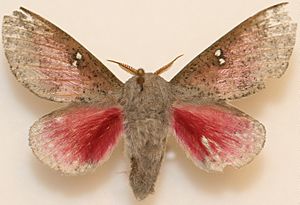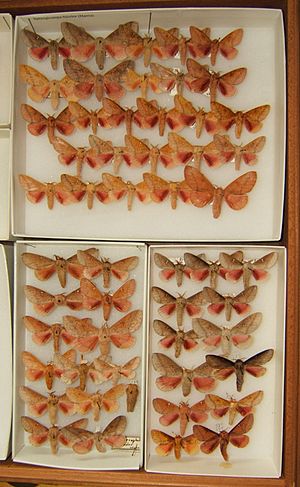Honey locust moth facts for kids
Quick facts for kids Honey locust moth |
|
|---|---|
 |
|
| Scientific classification | |
| Synonyms | |
|
The honey locust moth (scientific name: Syssphinx bicolor) is a type of moth found in North America. It belongs to a family of moths called Saturniidae, which are often large and colorful. This moth gets its name because its caterpillars often eat the leaves of the honey locust tree.
Contents
About the Honey Locust Moth
The honey locust moth has wings that can be many different colors. They might be gray, yellow, orange, or even a dark reddish-brown. You'll often see black spots and pinkish areas on their wings.
On the front wings, there's a special line called the "postmedial line." It runs towards the front edge of the wing before the tip. Sometimes, these moths have a white spot on their front wing, which can be single, double, or even missing.
These moths are a good size, with a wingspan (the distance from one wingtip to the other) that measures about 4.7 to 6.7 centimeters. That's about the length of your palm!
Similar Moths
There's another moth that looks very much like the honey locust moth. It's called the bisected honey locust moth (Sphingicampa bisecta). You can find it in the same areas.
The bisected honey locust moth is usually a bit bigger. It also has a straighter line on its wings that goes all the way to the tip. Plus, it doesn't have that white spot on its front wing that the honey locust moth sometimes has.
Where They Live
Honey locust moths mostly live in woodlands. This means they like areas with lots of trees, where they can find their favorite plants to eat.
When They Fly
You can spot these moths flying from April all the way through September. They are active during the warmer months of the year.
Life Cycle and Reproduction
-
2nd instar larva
The life of a honey locust moth starts as a tiny, pale green egg. The mother moth lays these eggs in small groups on the leaves of plants that her caterpillars will eat.
When the eggs hatch, tiny larvae (caterpillars) emerge. At first, these young caterpillars are pale green. They have four pairs of black, horn-like parts on their front body and a black horn at the end of their tail. They also have a white stripe along their side. These young caterpillars often stay together in groups.
As they grow, the caterpillars change. Older caterpillars are grass green and live by themselves. They have two pairs of red horns on their front body and one red horn at the end of their tail. They also have many shiny, silver horns along their body. A red and white stripe runs along their side, and their body is covered with small white dots. The caterpillars of the bisected honey locust moth look similar, but their horns are green, and they don't have the red color in their side stripe.
When a caterpillar is fully grown, it turns into a dark chrysalis. This chrysalis is made in a small cell underground. The moth spends the winter in this chrysalis stage, which is like a long sleep called hibernation.
Honey locust moths can have three groups of offspring (called "broods") in one year. The first moths to emerge in spring are usually grayish. The second group, appearing later, are often yellow to orange-brown. The last group of moths, born towards the end of the season, tend to be darker with more spots.
Host Plants
The honey locust moth caterpillars need specific plants to eat and grow. These are called "host plants." Here are some of their favorites:
- Honey locust tree, known scientifically as Gleditsia triacanthos
- Kentucky coffee tree, known scientifically as Gymnocladus dioicus






